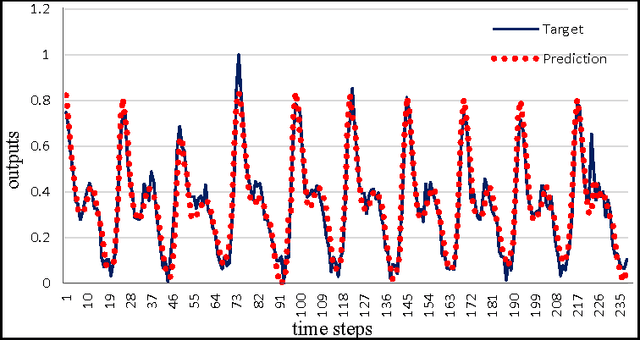Václav Snášel
Predictive modeling of die filling of the pharmaceutical granules using the flexible neural tree
May 16, 2017



Abstract:In this work, a computational intelligence (CI) technique named flexible neural tree (FNT) was developed to predict die filling performance of pharmaceutical granules and to identify significant die filling process variables. FNT resembles feedforward neural network, which creates a tree-like structure by using genetic programming. To improve accuracy, FNT parameters were optimized by using differential evolution algorithm. The performance of the FNT-based CI model was evaluated and compared with other CI techniques: multilayer perceptron, Gaussian process regression, and reduced error pruning tree. The accuracy of the CI model was evaluated experimentally using die filling as a case study. The die filling experiments were performed using a model shoe system and three different grades of microcrystalline cellulose (MCC) powders (MCC PH 101, MCC PH 102, and MCC DG). The feed powders were roll-compacted and milled into granules. The granules were then sieved into samples of various size classes. The mass of granules deposited into the die at different shoe speeds was measured. From these experiments, a dataset consisting true density, mean diameter (d50), granule size, and shoe speed as the inputs and the deposited mass as the output was generated. Cross-validation (CV) methods such as 10FCV and 5x2FCV were applied to develop and to validate the predictive models. It was found that the FNT-based CI model (for both CV methods) performed much better than other CI models. Additionally, it was observed that process variables such as the granule size and the shoe speed had a higher impact on the predictability than that of the powder property such as d50. Furthermore, validation of model prediction with experimental data showed that the die filling behavior of coarse granules could be better predicted than that of fine granules.
Ensemble of heterogeneous flexible neural trees using multiobjective genetic programming
May 16, 2017



Abstract:Machine learning algorithms are inherently multiobjective in nature, where approximation error minimization and model's complexity simplification are two conflicting objectives. We proposed a multiobjective genetic programming (MOGP) for creating a heterogeneous flexible neural tree (HFNT), tree-like flexible feedforward neural network model. The functional heterogeneity in neural tree nodes was introduced to capture a better insight of data during learning because each input in a dataset possess different features. MOGP guided an initial HFNT population towards Pareto-optimal solutions, where the final population was used for making an ensemble system. A diversity index measure along with approximation error and complexity was introduced to maintain diversity among the candidates in the population. Hence, the ensemble was created by using accurate, structurally simple, and diverse candidates from MOGP final population. Differential evolution algorithm was applied to fine-tune the underlying parameters of the selected candidates. A comprehensive test over classification, regression, and time-series datasets proved the efficiency of the proposed algorithm over other available prediction methods. Moreover, the heterogeneous creation of HFNT proved to be efficient in making ensemble system from the final population.
Metaheuristic Design of Feedforward Neural Networks: A Review of Two Decades of Research
May 16, 2017



Abstract:Over the past two decades, the feedforward neural network (FNN) optimization has been a key interest among the researchers and practitioners of multiple disciplines. The FNN optimization is often viewed from the various perspectives: the optimization of weights, network architecture, activation nodes, learning parameters, learning environment, etc. Researchers adopted such different viewpoints mainly to improve the FNN's generalization ability. The gradient-descent algorithm such as backpropagation has been widely applied to optimize the FNNs. Its success is evident from the FNN's application to numerous real-world problems. However, due to the limitations of the gradient-based optimization methods, the metaheuristic algorithms including the evolutionary algorithms, swarm intelligence, etc., are still being widely explored by the researchers aiming to obtain generalized FNN for a given problem. This article attempts to summarize a broad spectrum of FNN optimization methodologies including conventional and metaheuristic approaches. This article also tries to connect various research directions emerged out of the FNN optimization practices, such as evolving neural network (NN), cooperative coevolution NN, complex-valued NN, deep learning, extreme learning machine, quantum NN, etc. Additionally, it provides interesting research challenges for future research to cope-up with the present information processing era.
An Experimental Analysis of the Echo State Network Initialization Using the Particle Swarm Optimization
Jan 02, 2015



Abstract:This article introduces a robust hybrid method for solving supervised learning tasks, which uses the Echo State Network (ESN) model and the Particle Swarm Optimization (PSO) algorithm. An ESN is a Recurrent Neural Network with the hidden-hidden weights fixed in the learning process. The recurrent part of the network stores the input information in internal states of the network. Another structure forms a free-memory method used as supervised learning tool. The setting procedure for initializing the recurrent structure of the ESN model can impact on the model performance. On the other hand, the PSO has been shown to be a successful technique for finding optimal points in complex spaces. Here, we present an approach to use the PSO for finding some initial hidden-hidden weights of the ESN model. We present empirical results that compare the canonical ESN model with this hybrid method on a wide range of benchmark problems.
 Add to Chrome
Add to Chrome Add to Firefox
Add to Firefox Add to Edge
Add to Edge